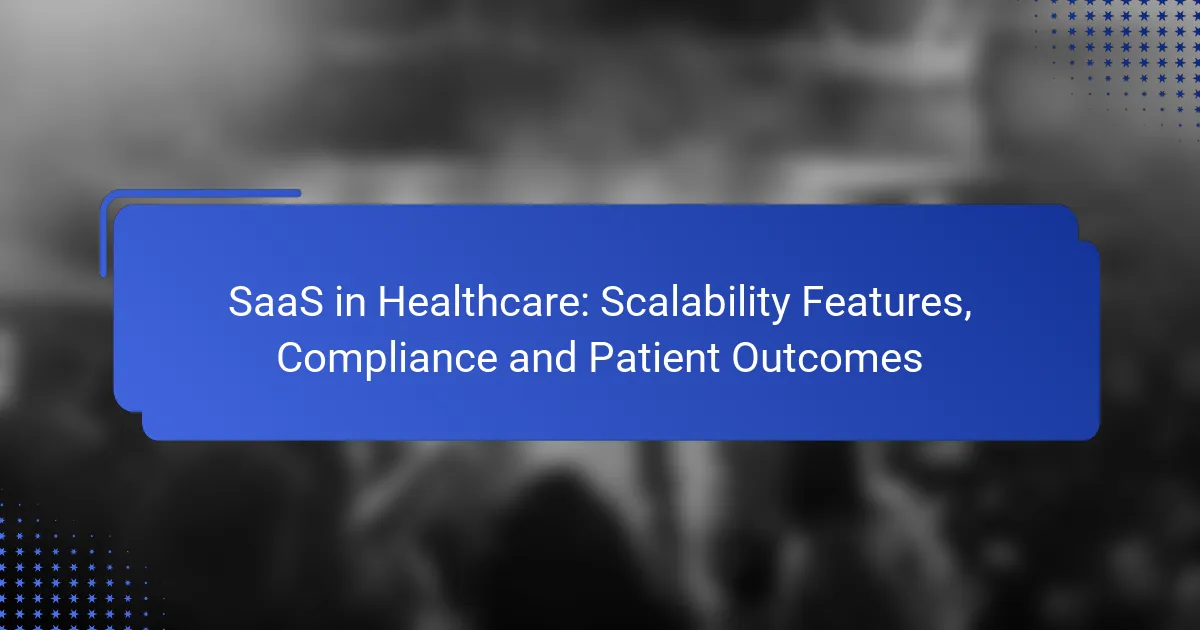Software as a Service (SaaS) in healthcare offers essential scalability features such as cloud-based infrastructure and automated resource allocation, enabling organizations to effectively manage growing data and user demands. Additionally, these solutions ensure compliance with regulations while enhancing patient outcomes through improved communication and streamlined processes, ultimately leading to more personalized care.
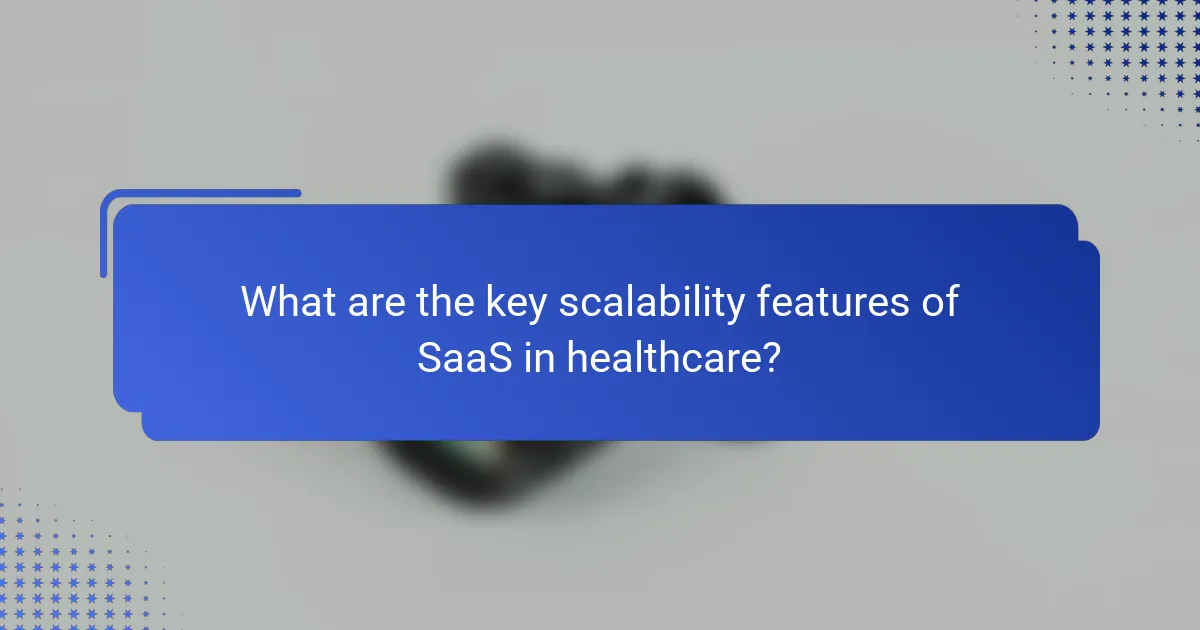
What are the key scalability features of SaaS in healthcare?
The key scalability features of SaaS in healthcare include cloud-based infrastructure, automated resource allocation, multi-tenant architecture, and integration capabilities with EHR systems. These features enable healthcare organizations to efficiently manage increasing data loads and user demands while maintaining compliance and enhancing patient outcomes.
Cloud-based infrastructure
Cloud-based infrastructure allows healthcare providers to access applications and data remotely, facilitating scalability. This means that as patient volumes increase, organizations can easily expand their storage and processing capabilities without significant upfront investments in hardware.
Providers can choose from various cloud service models, such as public, private, or hybrid clouds, depending on their specific needs and compliance requirements. This flexibility helps in managing costs while ensuring that sensitive patient data remains secure.
Automated resource allocation
Automated resource allocation optimizes the use of computing resources based on real-time demand. This feature ensures that healthcare applications can scale up or down automatically, depending on the number of users accessing the system or the volume of data being processed.
For instance, during peak times, such as flu season, the system can allocate additional resources to handle increased patient registrations and data processing without manual intervention. This not only improves efficiency but also enhances the user experience for both healthcare providers and patients.
Multi-tenant architecture
Multi-tenant architecture allows multiple healthcare organizations to share the same software instance while keeping their data separate and secure. This approach reduces costs and simplifies maintenance, as updates can be deployed across all tenants simultaneously.
By leveraging multi-tenant systems, smaller healthcare providers can access advanced features that might otherwise be unaffordable. This democratization of technology helps improve patient care across various settings, from small clinics to large hospitals.
Integration capabilities with EHR systems
Integration capabilities with Electronic Health Record (EHR) systems are crucial for seamless data flow between different healthcare applications. Effective SaaS solutions can connect with existing EHRs, allowing for real-time data updates and improved patient management.
Healthcare organizations should prioritize SaaS providers that offer robust APIs and interoperability standards, such as HL7 or FHIR. This ensures that patient data is consistently accurate and accessible, ultimately leading to better clinical outcomes and enhanced patient satisfaction.
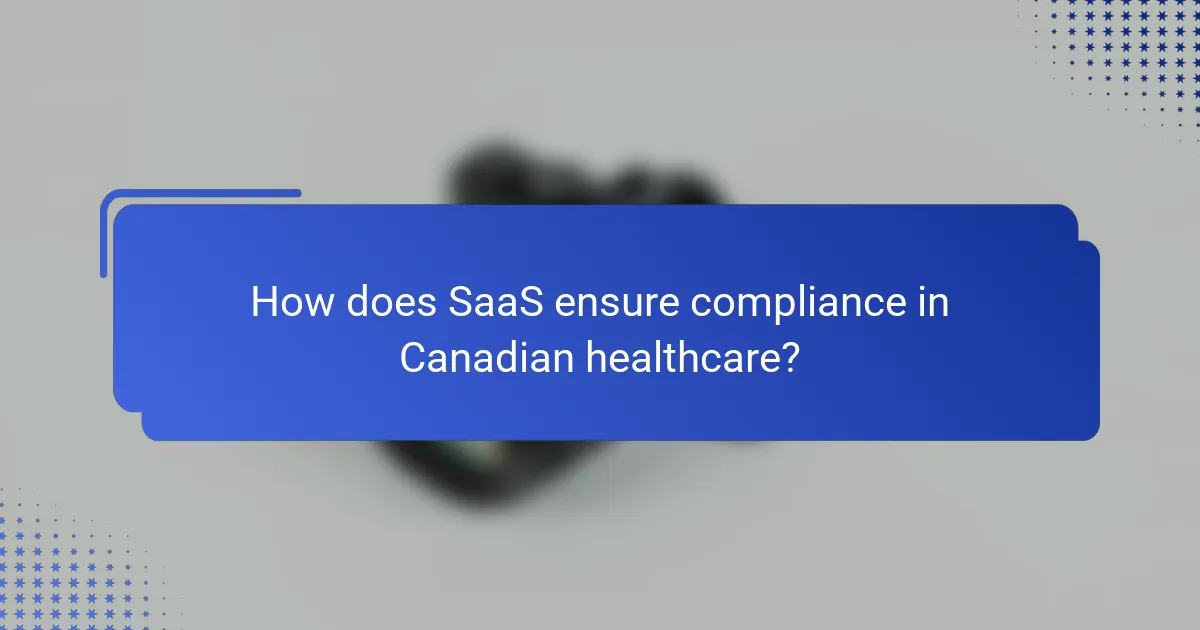
How does SaaS ensure compliance in Canadian healthcare?
SaaS solutions in Canadian healthcare ensure compliance through adherence to regulations, robust data protection measures, and regular security assessments. These practices help healthcare organizations meet legal requirements while safeguarding patient information.
Adherence to PIPEDA regulations
PIPEDA, or the Personal Information Protection and Electronic Documents Act, governs how private sector organizations collect, use, and disclose personal information in Canada. SaaS providers must implement policies and practices that align with PIPEDA to protect patient data and ensure transparency.
Healthcare organizations should verify that their SaaS vendors have documented compliance strategies, including consent management and data access protocols. Regular training for staff on PIPEDA requirements is also essential to maintain compliance.
Data encryption standards
Data encryption is crucial for protecting sensitive patient information stored in SaaS applications. Canadian healthcare SaaS solutions typically employ encryption protocols such as AES-256 to secure data both at rest and in transit.
Organizations should ensure that their SaaS providers utilize strong encryption methods and regularly update their security measures to address emerging threats. Additionally, verifying that encryption keys are managed securely is vital for maintaining data integrity.
Regular security audits
Conducting regular security audits is a key practice for ensuring compliance in SaaS healthcare solutions. These audits help identify vulnerabilities and assess the effectiveness of existing security measures.
Healthcare organizations should require their SaaS vendors to perform third-party audits and provide reports on their findings. Establishing a schedule for these audits, such as annually or biannually, can help maintain ongoing compliance and improve overall security posture.

What impact does SaaS have on patient outcomes?
SaaS solutions significantly enhance patient outcomes by streamlining healthcare processes and improving access to information. These platforms facilitate better communication between patients and providers, leading to more informed decisions and personalized care.
Improved access to health records
SaaS applications allow patients and healthcare providers to access health records anytime and anywhere, which is crucial for timely decision-making. This accessibility can reduce delays in treatment and improve the overall quality of care.
For instance, a patient can view their lab results or medication history through a secure portal, enabling them to engage more actively in their healthcare. This transparency fosters trust and encourages adherence to treatment plans.
Enhanced patient engagement tools
Many SaaS platforms offer tools that promote patient engagement, such as appointment reminders, educational resources, and communication channels with healthcare providers. These features help keep patients informed and involved in their care, which can lead to better health outcomes.
For example, a mobile app may send reminders for medication refills or upcoming appointments, ensuring patients stay on track with their treatment. Engaged patients are more likely to follow through with prescribed therapies and attend regular check-ups.
Data analytics for personalized care
SaaS solutions often include advanced data analytics capabilities that allow healthcare providers to tailor treatments based on individual patient data. By analyzing trends and outcomes, providers can identify the most effective interventions for specific patient populations.
For instance, predictive analytics can help identify patients at risk for chronic conditions, enabling early interventions that can significantly improve long-term health outcomes. This data-driven approach ensures that care is not only reactive but also proactive.
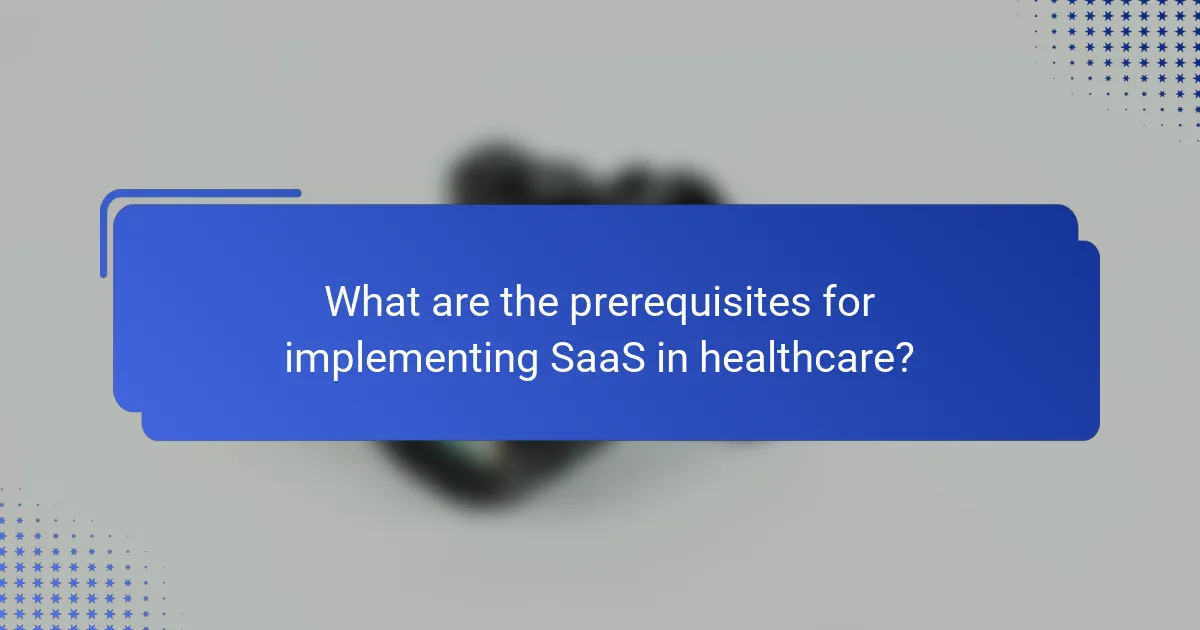
What are the prerequisites for implementing SaaS in healthcare?
Implementing SaaS in healthcare requires a solid IT foundation, staff readiness, and compliance with regulations. Organizations must assess their current infrastructure and ensure that employees are trained to effectively use the new system.
Assessment of current IT infrastructure
A thorough evaluation of the existing IT infrastructure is essential before adopting a SaaS solution. This assessment should identify hardware capabilities, network bandwidth, and integration points with current systems. Ensuring that the infrastructure can support the new software is crucial for seamless operation.
Consider conducting a gap analysis to pinpoint areas needing upgrades or enhancements. For instance, if your current network struggles with high traffic, investing in improved bandwidth may be necessary to accommodate the SaaS application effectively.
Staff training and onboarding
Effective staff training and onboarding are vital for the successful implementation of SaaS in healthcare. Employees must understand how to navigate the new system, utilize its features, and adhere to compliance standards. A structured training program can help facilitate this transition.
Utilize a mix of training methods, such as hands-on workshops, online tutorials, and ongoing support. Providing resources like quick reference guides can also assist staff in adapting to the new software. Regular feedback sessions can help identify any challenges and ensure that staff feel confident in using the new system.
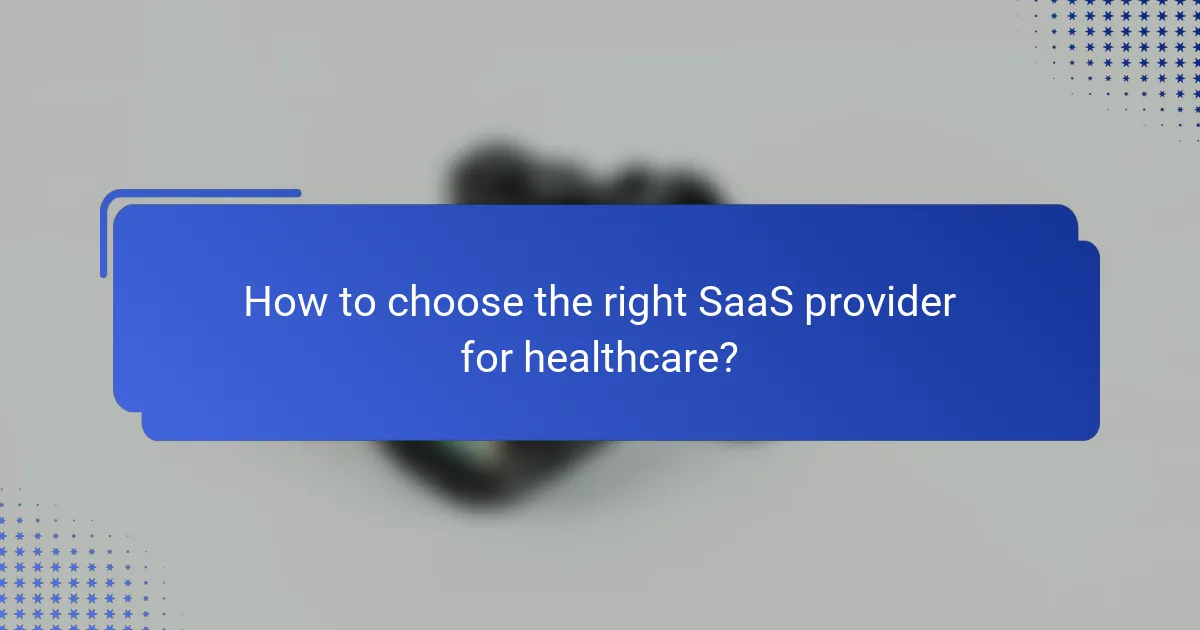
How to choose the right SaaS provider for healthcare?
Choosing the right SaaS provider for healthcare involves assessing compliance, scalability, and customer support. Prioritize vendors that meet industry regulations and can adapt to your organization’s growth while providing reliable assistance.
Evaluation of vendor compliance certifications
Compliance certifications are crucial in healthcare SaaS, as they ensure the provider adheres to industry standards such as HIPAA in the U.S. or GDPR in Europe. Verify that the vendor holds relevant certifications and regularly undergoes audits to maintain compliance.
Look for certifications like HITRUST CSF, ISO 27001, or SOC 2, which indicate a commitment to data security and privacy. Request documentation to confirm their compliance status and understand their data handling practices.
Comparison of scalability options
Scalability is essential for healthcare organizations that may experience fluctuations in patient volume. Evaluate how easily the SaaS solution can expand or contract based on your needs, including user capacity and feature enhancements.
Consider whether the provider offers tiered pricing models that allow you to scale without significant upfront costs. A flexible solution can adapt to your growth, whether you are a small clinic or a large hospital network.
Review of customer support services
Robust customer support is vital for healthcare SaaS, as downtime can impact patient care. Assess the availability and responsiveness of support services, including options for 24/7 assistance and dedicated account managers.
Check user reviews and testimonials to gauge the quality of support. A provider with a strong track record in customer service can help resolve issues quickly, ensuring minimal disruption to your operations.

What are the emerging trends in SaaS for healthcare?
Emerging trends in SaaS for healthcare focus on enhancing patient care through advanced technology, compliance with regulations, and improving operational efficiency. Key developments include AI integration, telehealth solutions, and data interoperability, all aimed at better patient outcomes and streamlined processes.
AI integration for predictive analytics
AI integration in healthcare SaaS platforms allows for predictive analytics, which can significantly enhance decision-making and patient outcomes. By analyzing vast amounts of data, these systems can identify patterns and predict potential health issues before they arise.
Healthcare providers can use predictive analytics to manage patient care more effectively. For example, AI can forecast patient admissions based on historical data, helping hospitals allocate resources more efficiently. This proactive approach can lead to reduced wait times and improved patient satisfaction.
When implementing AI-driven predictive analytics, it is crucial to ensure data quality and compliance with regulations such as HIPAA in the United States. Providers should also consider the ethical implications of AI decisions and maintain transparency with patients regarding how their data is used.
